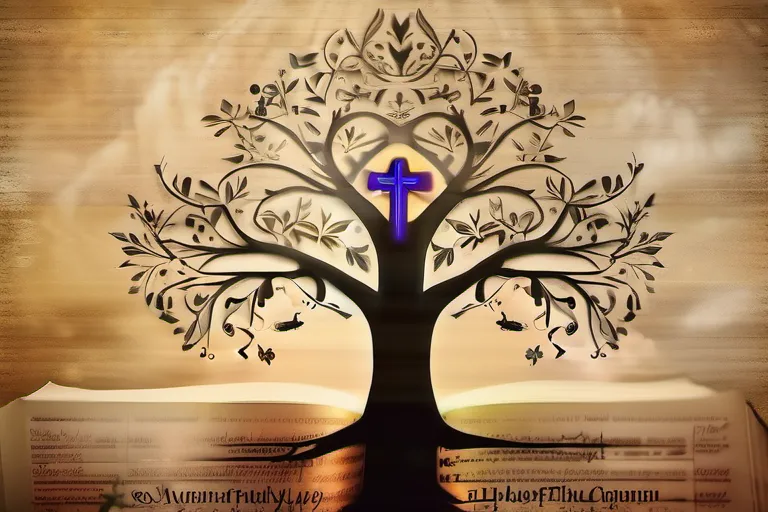Exploring the significance and interpretation of genealogies in the Old Testament from a Christian viewpoint.
The Old Testament is filled with genealogies, lists of ancestors that trace the lineage of important figures. As Christians, we believe these genealogies hold great significance and provide valuable insights into our faith. In this article, we will delve into how Christians explain and interpret these genealogies.
The Importance of Genealogies in the Old Testament
Imagine walking through the dense, ancient forests of biblical times, where every tree and stone holds stories waiting to be uncovered. Among these tales, the genealogies in the Old Testament stand like towering oaks, each branch representing a lineage that connects us to the roots of our faith.
Why do Christians find such significance in these tangled branches? After all, they seem like mere lists at first glance—names, dates, and places. But delve deeper, and you’ll discover a tapestry woven with threads of destiny and purpose. These genealogies are not just historical documents; they are gateways to understanding the divine plan unfolding through human history.
Consider The Bible as a vast river, and these genealogies as its tributaries—small yet essential in their contribution to the larger flow of salvation. They help us trace back to the source, reminding us that every individual mentioned in these records played a role, no matter how small it may seem.
But why bother with such detailed lineages? Could they not be simplified for modern readers? The answer lies in their symbolic weight. Genealogies serve as a bridge between the past and the present, linking our struggles and triumphs to those of our ancestors. They are like mirrors reflecting our own journey, showing us that God’s presence has been with humanity since the beginning.
Moreover, these genealogies offer a profound lesson in faithfulness and perseverance. Just as the patriarchs endured hardships and challenges, so too do we face trials today. Their stories remind us that even in times of darkness, there is hope, for God’s hand has always guided them.
So, next time you come across these genealogical records, ask yourself: What legacy am I leaving behind? And more importantly, how can I be a part of the ongoing story of faith and redemption?
The Genealogy of Jesus Christ
Imagine you’re tracing back the family tree of your best friend, only to find out that they are actually royalty. That’s a bit like what Christians do when they delve into the genealogy of Jesus Christ in the Old Testament. In Matthew and Luke, we see two different but interconnected narratives that present Jesus not just as a carpenter from Nazareth, but as the promised descendant of King David, the son of Abraham, and ultimately, the Son of God.
Why is this so important in Christian theology? It’s like finding out your friend isn’t just a regular person; they are the long-lost heir to a throne. This genealogy serves multiple purposes: it establishes Jesus’ legitimacy, it ties him into the broader narrative of the Old Testament, and it fulfills prophetic promises that have been waiting for centuries.
In Matthew’s account, we see Jesus as the son of David through Joseph, showing a direct lineage to the line of kings. Yet, in Luke’s genealogy, Jesus is traced back to Adam himself, forming an unbroken chain from humanity’s first father to the promised messiah. This dual approach emphasizes both the kingly and divine nature of Christ. It’s as if God has woven a tapestry where every thread counts – from Abraham to David, and finally to Joseph and Mary.
Moreover, these genealogies highlight the fulfillment of prophecy. Just like a detective piecing together clues to solve a mystery, Christians see these ancient records as revealing the hidden plan of salvation. Each name in the list is not just a historical fact but a step in the unfolding drama of redemption that culminates in Jesus’ life, death, and resurrection.
So, when you read through the genealogies in Matthew and Luke, remember that they are more than mere names on a page. They are the roadmap to understanding who Jesus is and why he came into this world – as the promised Messiah, the rightful king of kings, and the Savior of all humanity.
Genealogies as Prophetic Fulfillment
Genealogies in the Old Testament are often seen as more than just lists of names and dates; they serve as a prophetic roadmap, pointing towards the fulfillment of God’s promises to His people. Why else would so many genealogical records be meticulously preserved throughout the centuries? Could it be that these records held keys to understanding the grand narrative of salvation?
Consider the genealogy in 2 Samuel 7, where Nathan the prophet informs David about God’s promise to establish his dynasty. This prophecy is a precursor to the Christ who would come through the line of King David. How profound it must have been for Christians to realize that these ancient promises were not just historical records but prophetic fulfillments pointing towards the Messiah!
Similarly, in Isaiah 9, the prophet foretells the birth of a child who will be called Wonderful Counselor, Mighty God, Everlasting Father, and Prince of Peace. While this prophecy is often discussed in terms of its immediate context, it also holds deep significance for Christians as it hints at the fulfillment through Jesus Christ. These genealogies are like branches on a tree, each leading us closer to the trunk that represents the ultimate fulfillment of God’s promises.
How do we interpret these prophetic fulfillments? Is there a specific method or pattern in how they align with the genealogical records? Could it be that understanding these connections deepens our faith and provides clarity on who Jesus is and what He came to accomplish? As Christians, we are called to see beyond the surface and uncover the rich tapestry of divine revelation woven through the genealogies of the Old Testament.
Reflecting on these genealogies as prophetic fulfillments invites us to engage more deeply with Scripture. It challenges us to seek out patterns, connections, and meanings that point towards Christ. Just as a key opens a door, understanding these genealogies can open our hearts to the profound truths they contain.
In exploring how certain genealogies are seen as prophetic fulfillments by Christians, we are reminded of the interconnectedness of God’s plan from the beginning to the end. The Old Testament genealogies are not just historical documents; they are living testaments that point us towards Jesus Christ and the fulfillment of all His promises.
The Role of Genealogies in the Covenant Promises
Imagine walking through the pages of the Old Testament, where every name and lineage seems to whisper secrets of promise and covenant. Genealogies in the Old Testament are more than just lists of names; they are the DNA of God’s relationship with His chosen people. How do Christians interpret these genealogies as they relate to covenant promises?
Consider the Abrahamic Covenant, where God promised a nation through Abraham’s descendants. The genealogy of Genesis 11:26-32 traces back to Shem and Terah, setting the stage for Abraham’s emergence. This lineage is not just historical; it’s a bridge connecting past promises with future fulfillment. Christians see these genealogies as a map, guiding them through time to understand how God’s plans unfold.
Then there’s the Davidic Covenant in 2 Samuel 7:11-16, where God promises a king from the line of Jesse. The genealogy of David further emphasizes this promise, showing his connection to Jesse and ultimately to Solomon. These genealogies are not mere details; they’re pivotal markers on the path that leads to Christ’s kingship as the promised Messiah.
How do these genealogies fit into the bigger picture? They serve as a reminder that God is faithful to His promises, even when history seems to diverge. The line of Judah, through David and his descendants, foreshadows the coming of the Lamb of God who takes away the sin of the world. Each name in these genealogies points us toward Christ, whose birth fulfilled generations-old prophecies.
These covenant promises are not just historical records; they’re living testaments that speak to our faith today. When we read these genealogies, we see a God who is both patient and precise, weaving through the complexities of human history to fulfill His plans. How can you apply these lessons in your own spiritual journey? Are there moments when you feel disconnected from God’s promises? Remember, just like those ancestors, your place in the lineage of faith is also significant.
By understanding genealogies as prophetic fulfillments, we deepen our trust in God’s sovereignty and commitment to His people. They remind us that no matter how lost or forgotten we may feel, we are part of a grand narrative that has an ending – one where the promised King sits on David’s throne, reigning forever.
Genealogies as a Means of Preserving History
Imagine genealogies as the threads of a tapestry, each one carefully woven to create a rich and intricate design. These threads, much like the stories they tell, are crucial in understanding the fabric of Old Testament history. In this chapter, we explore how genealogies serve as a means of preserving history for Christians today.
Think about it: why would ancient authors go to such lengths to record who their ancestors were? Were these just dry, boring lists of names or did they hold more significance? Genealogies are not mere historical footnotes; they’re like keys that unlock the doors to understanding the covenant promises. Each name, each lineage, points to a broader narrative of God’s dealings with His people.
Consider the genealogy of Jesus in Matthew and Luke. These detailed lineages emphasize the divine plan woven through generations. By tracing Joseph’s family back to King David and beyond, we see how God’s promises were fulfilled in Christ. It’s as if every name mentioned is a step on the staircase leading to the climax of redemption.
For Christians today, genealogies offer a vital connection to our past. They remind us that our faith isn’t just an individual journey but part of a vast, ancient story. Just as the Israelites relied on their history to understand God’s faithfulness and plans, we too can find strength in knowing where we come from and recognizing the promises made by God centuries ago.
The preservation of these genealogies is not just about historical accuracy; it’s a testament to the importance of roots. Like trees with deep, sprawling root systems that anchor them firmly in the earth, Christians need their genealogical connections to stand strong in faith. These lines of descent are more than just records; they are lifelines that connect us to our heritage and guide us through uncertain times.
So, as we delve into these genealogies, let’s not dismiss them as mere lists but see them for what they truly are: a rich tapestry of history, faith, and divine promises. They are more than just historical artifacts; they are living threads that bind our past to our present and future.
Interpreting Genealogies: Challenges and Solutions
Interpreting genealogies in the Old Testament can often feel like untangling a complex web, where every strand seems to lead somewhere significant but not always obvious. How do we navigate these intricate family trees without getting lost? One challenge lies in understanding their purpose and structure. Are they simply lists of names or do they carry deeper theological significance?
Take the genealogy of Jesus, for instance, found in Matthew 1:1-17. These verses are not just a random recitation; each name is carefully chosen to highlight key figures who embody different aspects of God’s plan. How can we interpret these names and connections without missing their profound meanings? It’s like trying to decode an ancient treasure map where every clue leads us closer to understanding the divine purpose.
Another hurdle is reconciling the discrepancies between genealogies in different parts of the Old Testament. For example, why do Matthew’s and Luke’s accounts differ on Jesus’ lineage through Joseph? Could these differences be intentional, pointing to aspects of his divinity and humanity that are interwoven but not identical?
Understanding these challenges requires us to approach genealogies with a mix of curiosity and humility. We must recognize that these texts are rich with layers of meaning, inviting us to dig deeper. By doing so, we can uncover the stories of faith and destiny embedded within each name.
In the end, interpreting genealogies is not just about finding the right answers but also about embracing the journey of discovery. It’s a reminder that our own family histories are intertwined with God’s greater plan, making every lineage part of an unfolding narrative of redemption and hope.
Conclusion
 By understanding the purpose and meaning behind the genealogies in the Old Testament, we can gain a deeper appreciation for our faith and its rich history. We hope this article has provided you with valuable insights into this fascinating topic.
By understanding the purpose and meaning behind the genealogies in the Old Testament, we can gain a deeper appreciation for our faith and its rich history. We hope this article has provided you with valuable insights into this fascinating topic.











